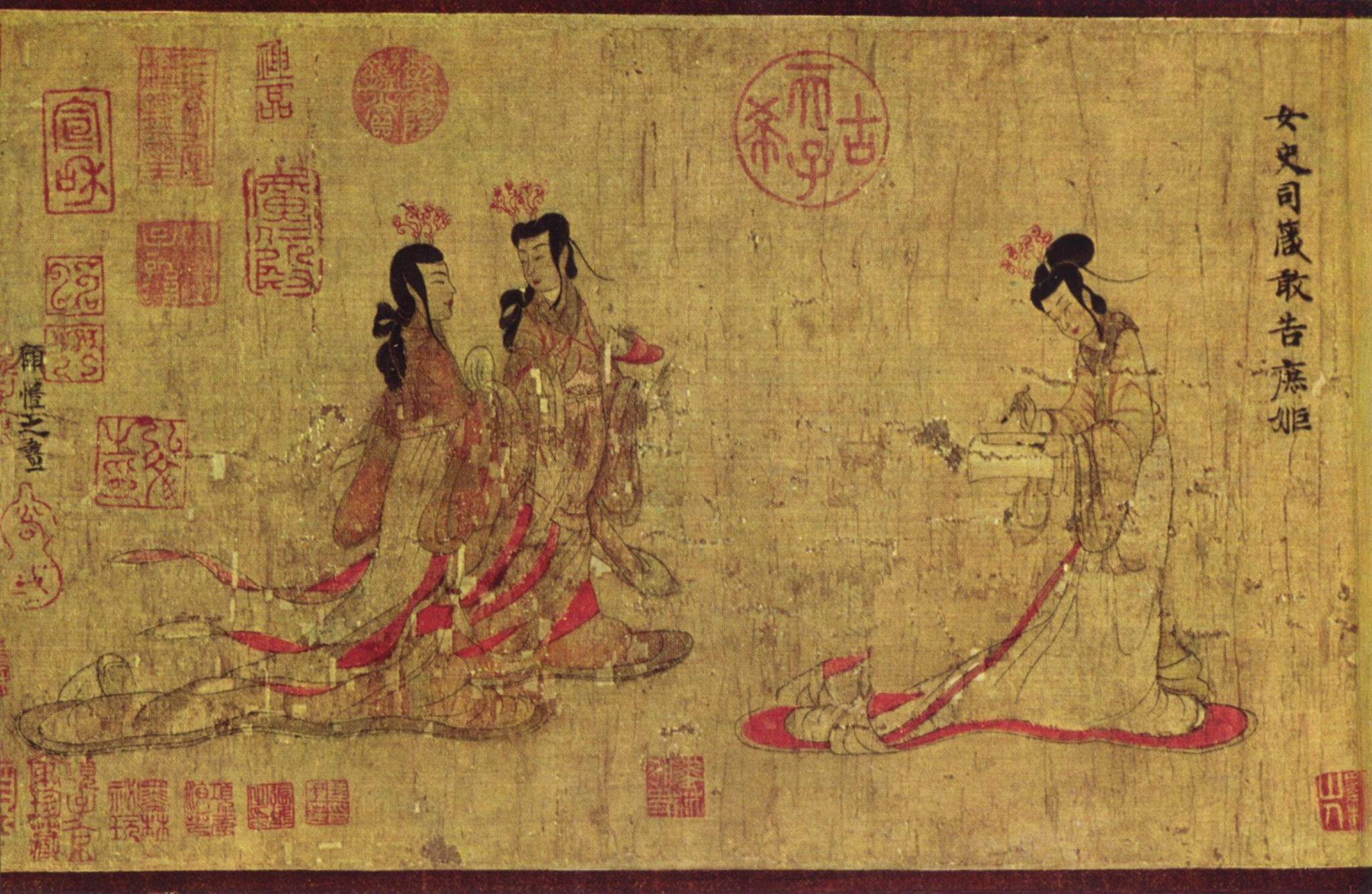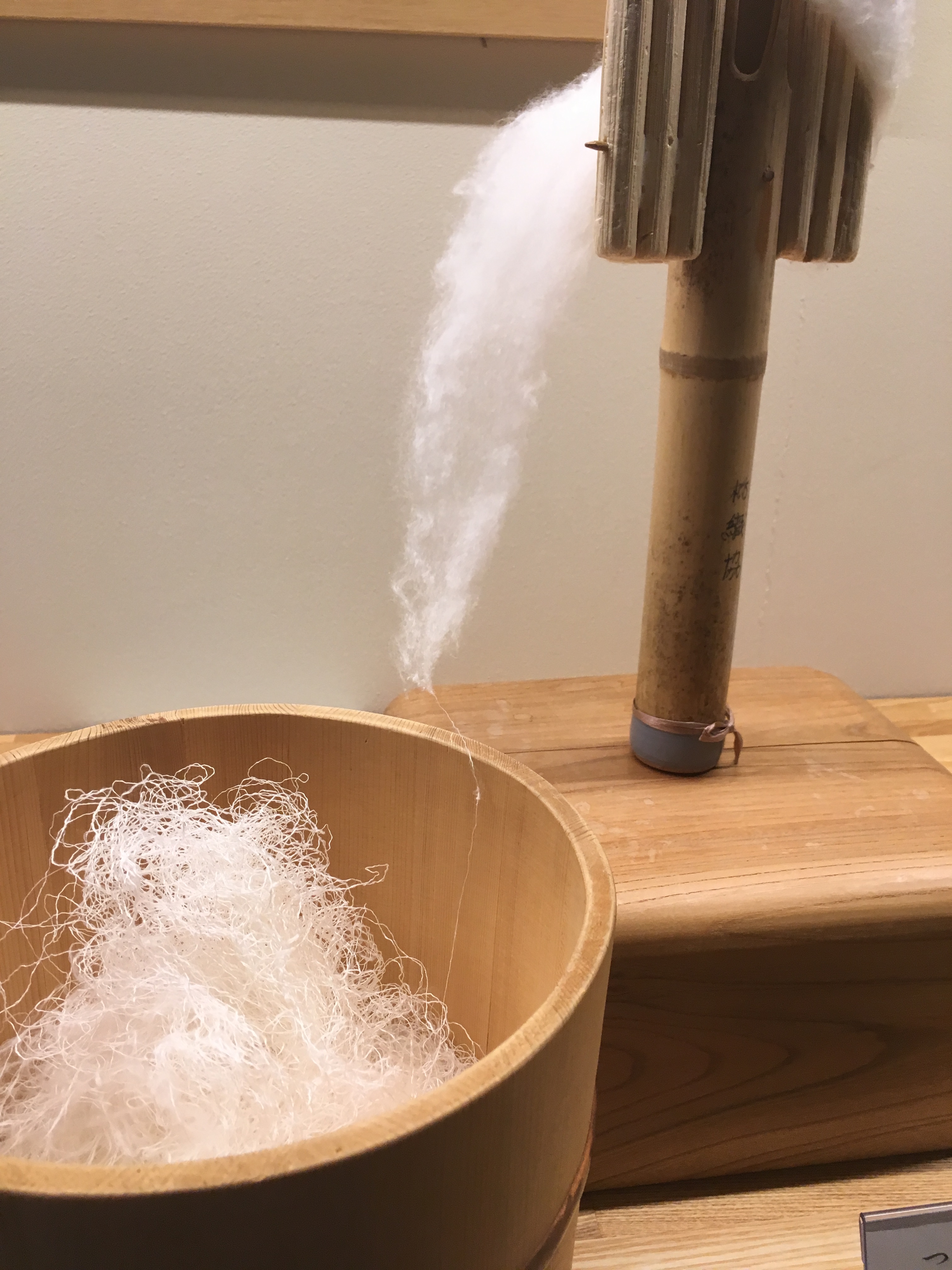A woman's virtue values gentleness; she conceals beauty within, and is pure and perfect.Gentle and meek, virtuous and careful, her proper place is in the chamber.When she gets married the girl arranges her robes and ties up her apron; respectfully she prepares the household meals.Solemn and dignified in bearing, with pure virtue she gazes up reverently.[3]
In context therefore, we see that the Kaizhi Bijin reveals much of the thinking and court politick of the Sixy Dynasties period, a turbulent time in which China was undergoing one of its many civil wars, power struggles and lethal men squabbles. The Bijin figure is represented as one of almost vice, lust and desire but only for the deserving few. Mortal women are certainly not meant to attain this level of control, and were repirmanded for thinking they could attain this level of desire in their own heteronormative relationships themselves. The Kaizhi Bijin therefore, is more a projection of male fantasy and the male gaze which asks almost impossible standards for earth women, and rather unreponsive and dismissivemiss glances for heavenly ones.
Bibliography
[1] https://en.wikipedia.org/wiki/Gu_Kaizhi
[2] https://en.wikipedia.org/wiki/Jia_Nanfeng
[3] From The Admonitions Scroll on Womens 'place in society'
[4] https://eclecticlight.co/2017/05/02/chinese-narrative-painting-the-nymph-of-the-luo-river/
[5] https://en.wikipedia.org/wiki/Duke_Ling_of_Wey
[6] https://en.wikipedia.org/wiki/Lady_Nanzi
Bijin Series Timeline
11th century BCE
- The Ruqun becomes a formal garment in China (1000 BCE) [Coming Soon]
8th century BCE
- Chinese clothing becomes highly hierarchical (771 BCE) [Coming Soon]
2cnd century BCE
- The Han Dynasty
0000 Current Era
Xi Shi (flourished c76); [Coming Soon]
1st century
- Han Tomb portraiture begins as an extension of Confucian Ancestor Worship; first Han aesthetic scholars dictate how East Asian composition and art ethics begin
- Isometric becomes the standard for East Asian Composition (c.100); Dahuting Tomb Murals
- Ban Zhao introduces Imperial Court to her Lessons for Women (c106); Women play major roles in the powerplay of running of China consistently until 1000 CE, influencing Beauty standards
- Qiyun Shengdong begins to make figures more plump and Bijin-like (c.150) but still pious
4th century
Gu Kaizhi (active 364-406); Metaphorical Beauty
- Chinese Artists begin to make aesthetic beauties in ethereal religious roles of heavenly Nymphs
- Luo River Nymph Tale (c.400)
- Womens clothing emphasized the waist as the Guiyi (Swallow-Tail Flying Ribbons) style (c.400)
- Wise and Benevolent Women (c.400)
5th century
- Chinese Art becomes decadent; Imperial Culture begins to see more expression in religious statues (c450)
- Longmen Grotto Boddhisattvas (471)
6th century
- Women begin writing Pining Love poetry inspiring many artists
Xu Ling; (active 537-583); Gongti or Palace Bijin [Coming Soon] https://www.jstor.org/stable/495525?seq=2#metadata_info_tab_contents
7th century
- Tang Dynasty Art (618-908)
- Rouged Bijin (600-699 CE) [Coming Soon] https://commons.wikimedia.org/wiki/Category:Paintings_of_the_Tang_Dynasty
Yan Liben (active 642-673); Bodhisattva Bijin [Coming Soon] https://commons.wikimedia.org/wiki/File:%E0%B8%81%E0%B8%A7%E0%B8%99%E0%B8%AD%E0%B8%B4%E0%B8%A1.jpg Guan Yin
Wu Zetian (active 665-705); The Great Tang Art Patron [Coming Soon]
Asuka Bijin (c.699); The Wa Bijin
8th century
- Princess Yongtai's Veneration Murals (701) [Coming Soon]
- Introduction of Chinese Tang Dynasty clothing (710)
- Sumizuri-e (710)
Yang Yuhuan Guifei (719-756); [Coming Soon] East Asian Supermodel Bijin https://core.ac.uk/download/pdf/275768522.pdf https://factsanddetails.com/china/cat2/4sub9/entry-5437.html#chapter-5
Zhang Xuan (active 720-755); [Coming Soon]
- What is now Classical Chinese Art forms
- An Lushun Rebellion (757)
Zhou Fang (active 766-805) ; Qiyun Bijin
- Emakimono Golden Age (799-1400)
9th century
- Buddhist Bijin [Coming Soon] https://commons.wikimedia.org/wiki/Category:Paintings_of_the_Tang_Dynasty#/media/File:Noble_Ladies_Worshiping_Buddha.jpg + https://en.wikipedia.org/wiki/Mogao_Caves#/media/File:Anonymous-Bodhisattva_Leading_the_Way.jpg
10th century
-End of Tang Art (907)
13th century
- Heimin painters; 1200-1850; Town Beauty
15th century
- Fuzokuga Painting schools; Kano (1450-1868) and Tosa (1330-1690)
Tang Yin (active 1490-1524); Chinese Beauties [Coming Soon] https://www.comuseum.com/painting/masters/tang-yin/
16 century
- Nanbanjin Art (1550-1630)
- Wamono style begins under Chanoyu teachings (c1550-1580)
- Byobu Screens (1580-1670)
- End of Sengoku Jidai brings Stabilisation policy (1590-1615)
17th century
- Land to Currency based Economy Shift (1601-1655)
- Early Kabuki Culture (1603-1673) ; Yakusha-e or Actor Prints
- Machi-Eshi Art ( 1610 - 1710) ; The Town Beauty
- Sumptuary legislation in reaction to the wealth of the merchant classes (1604-1685)
- Regulation of export and imports of foreign trade in silk and cotton (1615-1685)
Iwasa Matabei (active 1617-1650) ; Yamato-e Bijin
The Hikone Screen (c.1624-1644) [Coming Soon]
- Sankin-Kotai (1635-1642) creates mass Urbanisation
- Popular culture and print media production moves from Kyoto to Edo (1635-1650); Kiyohara Yukinobu (1650-1682) ; Manji Classical Beauty
- Shikomi-e (1650-1670) and Kakemono-e which promote Androgynous Beauties;
Iwasa Katsushige (active 1650-1673) ; Kojin Bijin
- Mass Urbanisation instigates the rise of Chonin Cottage Industry Printing (1660-1690) ; rise of the Kabunakama Guilds and decline of the Samurai
- Kanazoshi Books (1660-1700); Koshokubon Genre (1659?-1661)
- Shunga (1660-1722); Abuna-e
Kanbun Master/School (active during 1661-1673) ; Maiko Bijin
- Hinagata Bon (1666 - 1850)
- Ukiyo Monogatari is published by Asai Ryoi (1666)
Yoshida Hanbei (active 1664-1689) ; Toned-Down Bijin
- Asobi/Suijin Dress Manuals (1660-1700)
- Ukiyo-e Art (1670-1900)
Hishikawa Moronobu (active 1672-1694) ; Wakashu Bijin
- Early Bijin-ga begin to appear as Kakemono (c.1672)
- Rise of the Komin-Chonin Relationship (1675-1725)
- The transit point from Kosode to modern Kimono (1680); Furisode, Wider Obi
- The Genroku Osaka Bijin (1680 - 1700) ; Yuezen Hiinakata
Sugimura Jihei (active 1681-1703) ; Technicolour Bijin
- The Amorous Tales are published by Ihara Saikaku (1682-1687)
Hishikawa Morofusa (active 1684-1704) [Coming Soon]
- The Beginning of the Genroku Era (1688-1704)
- The rise of the Komin and Yuujo as mainstream popular culture (1688-1880)
- The consolidation of the Bijinga genre as mainstream pop culture
- The rise of the Torii school (1688-1799)
- Tan-E (1688-1710)
Miyazaki Yuzen (active 1688-1736) ; Genroku Komin and Wamono Bijin
Torii Kiyonobu (active 1688 - 1729) : Commercial Bijin
Furuyama Moromasa (active 1695-1748)
18th century
Nishikawa Sukenobu (active 1700-1750) [Coming Soon]
Kaigetsudo Ando (active 1700-1736) ; Broadstroke Bijin
Okumura Masanobu (active 1701-1764)
Kaigetsudo Doshin (active 1704-1716) [Coming Soon]
Baioken Eishun (active 1710-1755) [Coming Soon]
Kaigetsudo Anchi (active 1714-1716) [Coming Soon]
Yamazaki Joryu (active 1716-1744) [Coming Soon]
1717 Kyoho Reforms
Miyagawa Choshun (active 1718-1753) [Coming Soon]
Miyagawa Issho (active 1718-1780) [Coming Soon]
Nishimura Shigenaga (active 1719-1756) [Coming Soon]
Matsuno Chikanobu (active 1720-1729) [Coming Soon]
- Beni-E (1720-1743)
Torii Kiyonobu II (active 1725-1760) [Coming Soon]
- Uki-E (1735-1760)
Kawamata Tsuneyuki (active 1736-1744) [Coming Soon]
Kitao Shigemasa (1739-1820)
Miyagawa Shunsui (active from 1740-1769) [Coming Soon]
Benizuri-E (1744-1760)
Ishikawa Toyonobu (active 1745-1785) [Coming Soon]
Tsukioka Settei (active 1753-1787) [Coming Soon]
Torii Kiyonaga (active 1756-1787) [Coming Soon]
Shunsho Katsukawa (active 1760-1793) [Coming Soon]
Utagawa Toyoharu (active 1763-1814) [Coming Soon]
Suzuki Harunobu (active 1764-1770) [Coming Soon]
- Nishiki-E (1765-1850)
Torii Kiyonaga (active 1765-1815) [Coming Soon]
Kitao Shigemasa (active 1765-1820) [Coming Soon]
Maruyama Okyo (active 1766-1795) [Coming Soon]
Kitagawa Utamaro (active 1770-1806) [Coming Soon]
Kubo Shunman (active 1774-1820) [Coming Soon]
Tsutaya Juzaburo (active 1774-1797) [Coming Soon]
Utagawa Kunimasa (active from 1780-1810) [Coming Soon]
Tanehiko Takitei (active 1783-1842) [Coming Soon]
Katsukawa Shuncho (active 1783-1795) [Coming Soon]
Choubunsai Eishi (active 1784-1829) [Coming Soon]
Eishosai Choki (active 1786-1808) [Coming Soon]
Rekisentei Eiri (active 1789-1801) [Coming Soon] [https://commons.wikimedia.org/wiki/Category:Ukiyo-e_paintings#/media/File:Rekisentei_Eiri_-_'800),_Beauty_in_a_White_Kimono',_c._1800.jpg]
Chokosai Eisho (active 1792-1799) [Coming Soon]
Kunimaru Utagawa (active 1794-1829) [Coming Soon]
Utagawa Toyokuni II (active 1794 - 1835) [Coming Soon]
Ryūryūkyo Shinsai (active 1799-1823) [Coming Soon]
19th century
Teisai Hokuba (active 1800-1844) [Coming Soon]
Totoya Hokkei (active 1800-1850) [Coming Soon]
Utagawa Kunisada Toyokuni III (active 1800-1865) [Coming Soon]
Urakusai Nagahide (active from 1804) [Coming Soon]
Kitagawa Tsukimaro (active 1804 - 1836)
Kikukawa Eizan (active 1806-1867) [Coming Soon]
Keisai Eisen (active 1808-1848) [Coming Soon]
Utagawa Kuniyoshi (active 1810-1861) [Coming Soon]
Utagawa Hiroshige (active 1811-1858) [Coming Soon]
Yanagawa Shigenobu (active 1818-1832) [Coming Soon]
Utagawa Kunisada II (active 1844-1880) [Coming Soon]
Toyohara Kunichika (active 1847-1900) [Coming Soon]
Kano Hogai (active 1848-1888) [Coming Soon]
Tsukioka Yoshitoshi (active 1850-1892) [Coming Soon]
Toyohara Chikanobu (active 1875-1912) [Coming Soon]
Kiyokata Kaburaki (active 1891-1972) [Coming Soon]
Goyo Hashiguchi (active 1899-1921) [Coming Soon]
20th century
Yumeji Takehisa (active 1905-1934) [Coming Soon]
Torii Kotondo (active 1915-1976) [Coming Soon]
Yamakawa Shūhō (active 1927-1944) [Coming Soon]
Social Links
One stop Link shop: https://linktr.ee/Kaguyaschest
https://www.etsy.com/uk/shop/KaguyasChest?ref=seller-platform-mcnav
https://www.instagram.com/kaguyaschest/
https://www.youtube.com/channel/UC5APstTPbC9IExwar3ViTZw
https://www.pinterest.co.uk/LuckyMangaka/hrh-kit-of-the-suke/
_por_Ku_K'ai-Chih._Copia_de_la_dinast%C3%ADa_Sung_(960-1279)_seg%C3%BAn_la_obra_original_del_siglo_%E2%85%A3.jpg)

,_Palace_Museum,_Beijing.jpg)
_por_Ku_K'ai-chih_-_Duque_Ling_de_Wey.jpg)
_4.jpg)





_Nymph_of_the_Luo_River._18_cent._National_Palace_Museum,_Taipei.jpg)
._(33%2C7x204%2C8)_Beijing_Palace_Museum.jpg)
.jpg)

.jpg)
.jpg)
.jpg)
.jpg)
.jpg)













.jpg)
